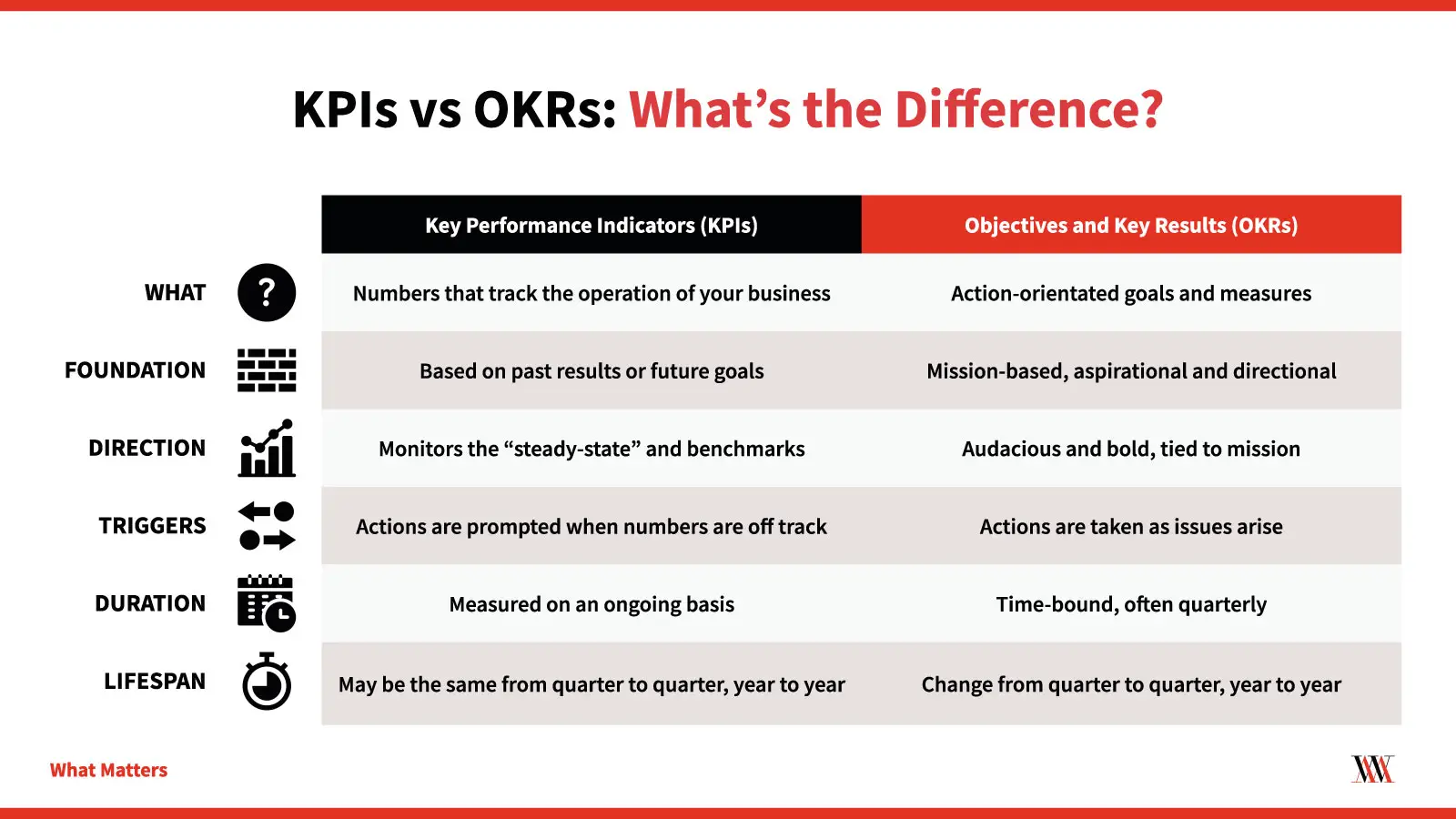Summary
OKRs (Objectives and Key Results) don’t replace KPIs, but they can help your team achieve them. OKRs add direction, purpose and context to your top priorities. Learn when to use an OKR instead of a KPI, how to turn an existing KPI into an OKR, and discover other ways KPIs and OKRs complement each other.
KPIs vs OKRs: The difference between KPIs and OKRs
Every organization has initiatives to help them grow, transform, and achieve operational excellence. Those initiatives are vital to long-term success, yet they are often vulnerable to getting lost in the day-to-day.
Most organizations are already familiar with KPIs, or Key Performance Indicators: periodic measurements that track how well your organization is doing. KPIs provide a general assessment of organizational health, highlighting important metrics like revenue, products manufactured, customer satisfaction, and email signups. But as standalone metrics, they don’t convey purpose, path or progress towards a goal.
KPIs most often monitor the “steady-state,” while OKRs describe outcomes – the results of our actions on our KPIs.
OKRs serve a more strategic purpose than KPIs by linking outcomes to an organization’s mission. They can also encourage teams to strive for outcomes that might initially seem out of reach by communicating more about why they matter than a typical KPI.
We like to say that OKRs are “KPIs with soul” – because they add direction and purpose to metrics. They often inspire ownership, which in turn drives operating excellence. Said more simply, a KPI tells you how you’re doing right now, and an OKR tells you why it matters to get “this far, this fast.”

Another key difference is KPIs are simply metrics, not a process or system. A group of KPIs does not necessarily add up to achieving a strategy. OKRs, on the other hand, are building blocks to achieving mission-critical goals and strategies. They are part of a larger process called the “OKR methodology” (and, confusingly, sometimes called “OKRs” for short). If your organization “uses OKRs,” they not only set goals, but also have a process for aligning and tracking progress regularly.
OKRs vs KPIs examples: What’s an example of a KPI?
Think about a racing team, whose mission is to have the fastest car in the world. That means they need a best speed between 224-228 mph. The team’s best speed is 225. That’s a KPI. Other examples might include “Number of pitstop-related issues per race” or “Incident rate during pit stops.” And while these might be important metrics to track, by themselves, these won’t transform the team’s performance.
OKRs vs KPIs: What’s an example of an OKR?
OKRs remind us where we need to focus our attention if we want to grow and excel. Let’s continue with our racing team example.
Remember the driver’s KPI of a best speed of 225 mph? That might be enough to compete at the highest level. But, this team has set an Objective: Win the Indy 500 this year.
To WIN, they have to improve significantly – something that would get them to the top one or two teams in the world.
That narrows their focus to a few options that would make a big difference.
In this scenario, the KPI of 225 mph doesn’t tell them how they’re going to win.
Instead, they create the first Key Result for their Objective:
O: Win the Indy 500.
As measured by:
KR1: Increase driver’s best speed from 225 to 228 mph.
KR2: Reduce time per lap to 0:39.5s.
KR3: Reduce average pitstop times by 15%.
The pit crew also takes their KPI of an average of 8-second pitstop times and turns it into an Objective to reduce their pitstop times – their second biggest opportunity for improvement.
An OKR example for the team could look like this:
O: Fastest pitstop times in the race.
As measured by:
KR1: Maintain an average pitstop time of less than 7 seconds in practice races.
KR2: Reduce equipment malfunction incidents by 50%.
KR3: Upgrade communications and boost team response times by 20%.
OKR vs KPI: Can OKRs replace KPIs?
Unlike the Indy 500, there is no competition between KPIs and OKRs. They complement each other. KPIs are key performance indicators, and OKRs can help you change and improve them. While KPIs often track ongoing metrics of health, or BAU, KPIs often inform — and even become — your OKRs, if it’s a measurement that you want to significantly change.
Think of it this way: OKRs describe where you want to be, not where you currently are. And once you’ve achieved an OKR, it might become a KPI you want to track on an ongoing basis.
Conclusion
KPIs and OKRs serve complementary roles. KPIs are metrics that reflect your current state, while OKRs are a framework for setting and achieving your goals. Both include metrics, but you may have KPIs for more than your OKRs, and OKRs add important context to your metrics. By integrating OKRs, you can elevate your KPIs from simple measurements to powerful tools to achieve your strategic goals.
Want to Learn More Ways OKRs Can Help You Meet Your Goals?
Take our OKRs 101 course, sign up for our Audacious newsletter or check out Google’s OKR Playbook.